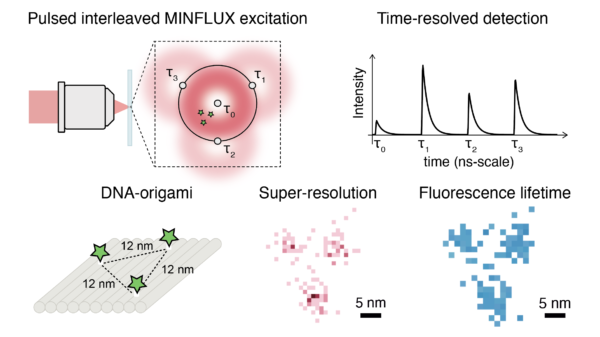Since its presentation in early 2017, MINFLUX has generated a lot of interest in the bioimaging community because it enables the localization of single fluorescent molecules with the highest precision, namely 1 nm or less, which is the size of the photon emitting conjugated systems in molecules. However, since then, no other lab in the world managed to put a MINFLUX system to work because of the high technical complexity. We are thus very happy to present pulsed-interleaved MINFLUX, a new implementation of MINFLUX that keeps the same performance as the original implementation, but with a considerably simpler set-up. In addition, p-MINFLUX gives direct access to excited-state lifetime information, expanding the range of applications to include sensing of molecular environments and interactions through energy transfer (e.g. FRET). This work was done in great collaboration with the group of Prof. Philip Tinnefeld (LMU). Florian Steiner from LMU came to CIBION, and Luciano Masullo went to LMU. We contributed with the optical design and instrumentation of the p-MINFLUX set-ups, and the LMU group designed and fabricated beautiful DNA-origami systems to demonstrate the performance of p-MINFLUX on single-molecule localization and tracking. Now, both groups count with fully running p-MINFLUX systems where new exciting measurements are being done!

Nano Letters 21 (2021) 840-846
“Pulsed Interleaved MINFLUX”
Luciano A. Masullo, Florian Steiner, Jonas Zähringer, Lucía F. Lopez, Johann Bohlen, Lars Richter, Fiona Cole, Philip Tinnefeld, Fernando D. Stefani
Original MINFLUX paper:
“Nanometer resolution imaging and tracking of fluorescent molecules with minimal photon fluxes”
Francisco Balzarotti, Yvan Eilers, Klaus C. Gwosch, Arvid H. Gynma, Volker Westphal, Fernando D. Stefani, Johan Elf, Stefan W. Hell



